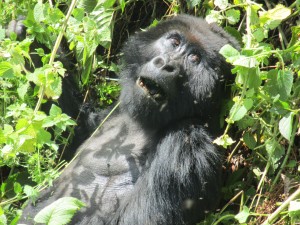 The third and final stop on our study tour of Rwanda brought us to the northwestern corner of the country, where a chain of dramatic volcanic peaks divides Rwanda from Uganda and the Democratic Republic of Congo. On the slopes of these volcanoes, over half (480 of 880 total) of the world’s remaining mountain gorillas make their home. Back in the late 1970s, Amy Vedder and her husband Bill Weber fought to launch a gorilla tourism program in Rwanda. At the time, the Rwandan government was moving forward with a large-scale cattle raising project that would have developed roughly a third of the country’s Volcanoes National Park, and would likely have spelled the end of the mountain gorilla. In a country starved for land and in need of economic development, the national park had little value to government or to the Rwandan people. Amy and Bill thought they could change that. They told the government that money—more money than could be made from the cattle-raising project—could be made from gorillas, if they were protected. They then went about the tricky work of setting up a high-value tourism program that is also sensitive to the health and well-being of gorillas.
The third and final stop on our study tour of Rwanda brought us to the northwestern corner of the country, where a chain of dramatic volcanic peaks divides Rwanda from Uganda and the Democratic Republic of Congo. On the slopes of these volcanoes, over half (480 of 880 total) of the world’s remaining mountain gorillas make their home. Back in the late 1970s, Amy Vedder and her husband Bill Weber fought to launch a gorilla tourism program in Rwanda. At the time, the Rwandan government was moving forward with a large-scale cattle raising project that would have developed roughly a third of the country’s Volcanoes National Park, and would likely have spelled the end of the mountain gorilla. In a country starved for land and in need of economic development, the national park had little value to government or to the Rwandan people. Amy and Bill thought they could change that. They told the government that money—more money than could be made from the cattle-raising project—could be made from gorillas, if they were protected. They then went about the tricky work of setting up a high-value tourism program that is also sensitive to the health and well-being of gorillas.
Today, mountain gorillas are the unquestioned centerpiece of Rwanda’s tourism offerings. Every day, a maximum of 64 (mostly Western) tourists visit the 8 gorilla families that have been habituated to people. Visits are limited to one hour per day and to a maximum of 8 people per group. And for that hour, tourists pay $750. Amy and Bill were right: people in the West would pay to see the gorillas, and, for now at least, the gorillas’ future seems secure. Since the gorilla tourism program began, the number of mountain gorillas in the region has climbed from 260 to 480. There is a lot of debate about the benefits and dangers of the commodification of nature (think ecosystem services or conservation programs like CAMPFIRE), but in this case at least, I think the math is sound: By showing that gorillas could “pay their way” (and then some), gorilla tourism saved the park and saved the mountain gorillas.
As we drove into the northwestern part of the country, we saw a monument to the gorillas with an inscription that read, according to our guide’s translation, something along the lines of, “Protect them, and we can milk them for foreign revenue.”
And then we were the tourists. We milled about with the other travelers while our guides haggled over which group of tourists would visit which of the 8 gorilla groups. Once this bit of business was decided, we were off, headed for the Amahoro (or “peace”) group. At first, we walked through farmers’ fields, rows of potatoes and beans jammed right up against the protected forest. (A rough stone wall has been erected to try to prevent Cape buffalo from leaving the forest and raiding adjacent farms.) And then we were in the park, where we became intimately, painfully acquainted with three different kinds of stinging nettles. Some grew on big beefy stalks with spiny leaves conveniently at face level, and they had no problem stinging us through our pants and shirts. In the distance, high above the nettles, we could see several dramatic volcanoes, including Karisimbi, which rises to almost 15,000 feet. And then, in the midst of a lush sea of green nettles, a large black shape: our first sighting of a mountain gorilla. Our hour passed quickly. We had been instructed to keep a certain distance from the gorillas, but the gorillas don’t seem to respect the rules. At times, we would have to lean back, trying to keep our footing on a steep, nettle-covered slope, to make room as a gorilla would push past us. It was an incredible experience to be in this remote, high-altitude jungle, right at the edge of the vast Democratic Republic of Congo, sharing an hour with these animals. We watched them loll about in the nettles, dozing and eating. And sometimes, as we stared at them, they would stare right back at us.